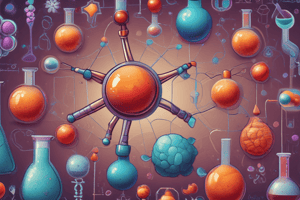Podcast
Questions and Answers
What is the smallest unit of an element that has all the chemical properties of that element?
What is the smallest unit of an element that has all the chemical properties of that element?
- Molecule
- Electron
- Proton
- Atom (correct)
How many types of particles make up an atom?
How many types of particles make up an atom?
- Five
- Three (correct)
- Four
- Two
What is a substance called that is composed entirely of one type of atom?
What is a substance called that is composed entirely of one type of atom?
- Element (correct)
- Compound
- Molecule
- Bond
Which of the following are examples of pure elements?
Which of the following are examples of pure elements?
What do you call it when two or more atoms bond together?
What do you call it when two or more atoms bond together?
Which combination forms the compound H₂O?
Which combination forms the compound H₂O?
What does each horizontal row in the periodic table represent?
What does each horizontal row in the periodic table represent?
In chemical equations, what do balanced symbols represent?
In chemical equations, what do balanced symbols represent?
Why is it important to balance chemical equations?
Why is it important to balance chemical equations?
What does combustion involve in chemistry?
What does combustion involve in chemistry?
What is the basis of chemical knowledge according to the text?
What is the basis of chemical knowledge according to the text?
What is the purpose of the periodic table according to the text?
What is the purpose of the periodic table according to the text?
Flashcards are hidden until you start studying
Study Notes
Chemical Connections: A Journey through the World of Chemistry
Chemistry is more than just liquids bubbling in flasks; it's the story of elements coming together to form molecules that shape our world. This exciting science explores matter, its properties, and how it reacts when combined, separated, or altered. Let's dive into some fundamental aspects of chemistry, discovering what makes this subject so fascinating and crucial to understanding ourselves and the universe around us.
Atoms and Elements
Atom — the smallest unit of an element that has all the chemical properties of that element — is the building block of everything we see. An atom consists of three types of particles: protons, neutrons, and electrons. Ninety-two different kinds of atoms make up the known elements on Earth. These unique combinations define each element's characteristics and reactivity.
A substance composed entirely of one type of atom is called a pure element. Some natural examples include gold, carbon, hydrogen, oxygen, copper, iron, nitrogen, sodium, and chlorine. Pure water (H₂O) also falls under this category since hydrogen and oxygen atoms combine to form it.
Molecules and Compounds
When two or more atoms bond together, they form molecules. For instance, H₂O comprises covalently bonded hydrogen and oxygen atoms. In contrast, compounds consist of two or more distinct elements chemically bound together. Common examples are table salt (NaCl), sugar (C₁₀H₁₂O₁₁), baking soda (NaHCO₃), and ammonia (NH₃).
The periodic table, developed by Dmitri Mendeleev, organizes elements based on their atomic number and properties. Each horizontal row represents a period, while the vertical columns represent groups with similar electron configurations. Comprehending the relationships between elements helps predict their reactions and interactions, forming the basis of chemical knowledge.
Reactions and Formulas
Reactions occur when atoms join together, separate, or change places within molecules. This process can lead either to synthesis (formation of new compounds), decomposition (breaking down complex substances into simpler ones), or combustion (oxidizing fuels like wood, coal, gasoline, or oil). During these processes, energy may be absorbed or released, changing the state of matter.
To describe reactions quantitatively, scientists employ chemical equations written with balanced symbols representing elements and compounds involved in the reaction. Each symbol indicates the number of moles (amount of matter) present before and after the reaction. Balancing chemical equations ensures both sides have equal amounts of each component participating in the process.
In summary, chemistry revolves around exploring the properties of matter, studying its behavior during various transformations, and decoding patterns underlying these changes. By learning the basics of chemical principles like those discussed above, you'll uncover an intriguingly diverse, interconnected world full of wonders waiting to be discovered.
Studying That Suits You
Use AI to generate personalized quizzes and flashcards to suit your learning preferences.




